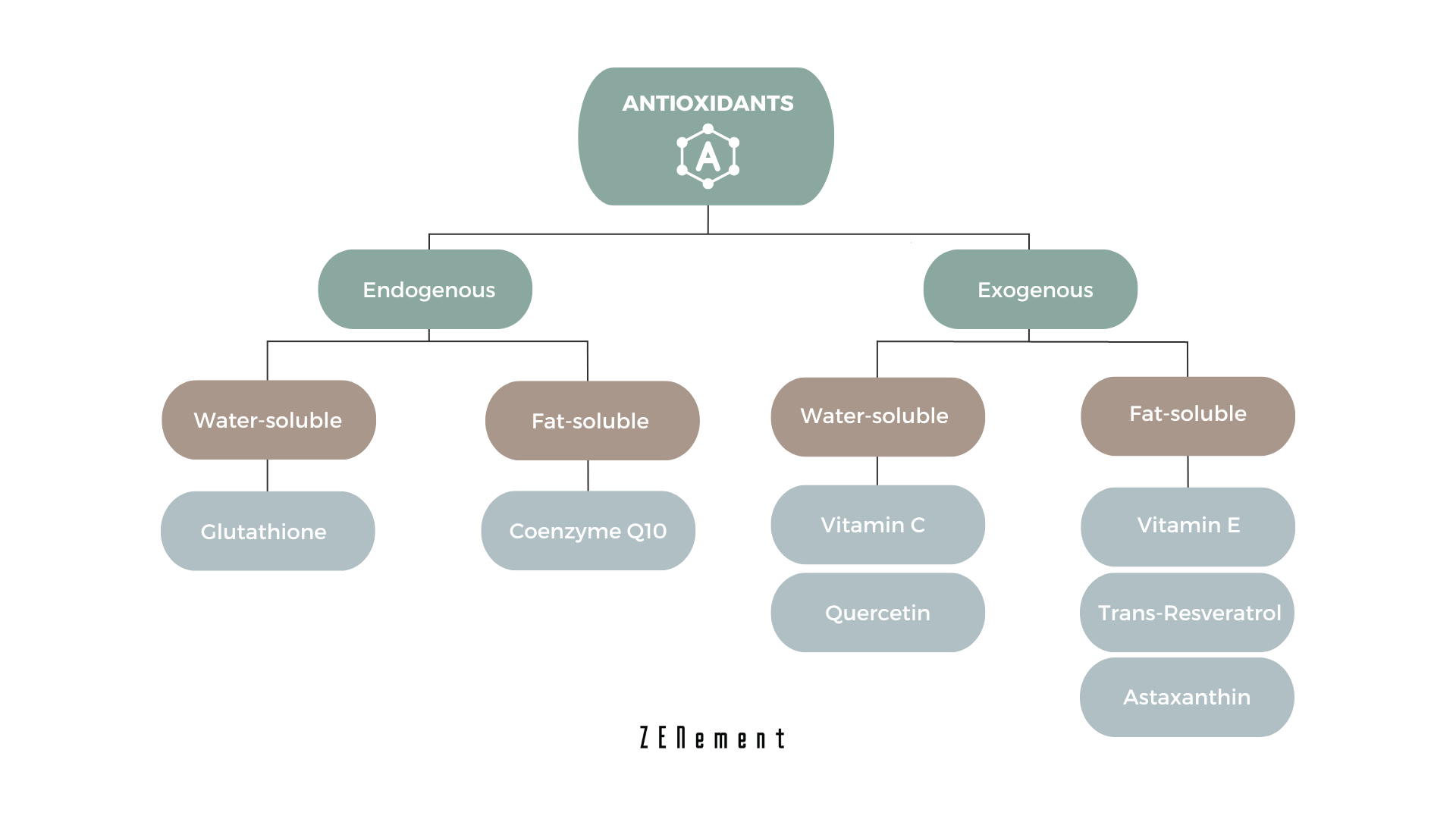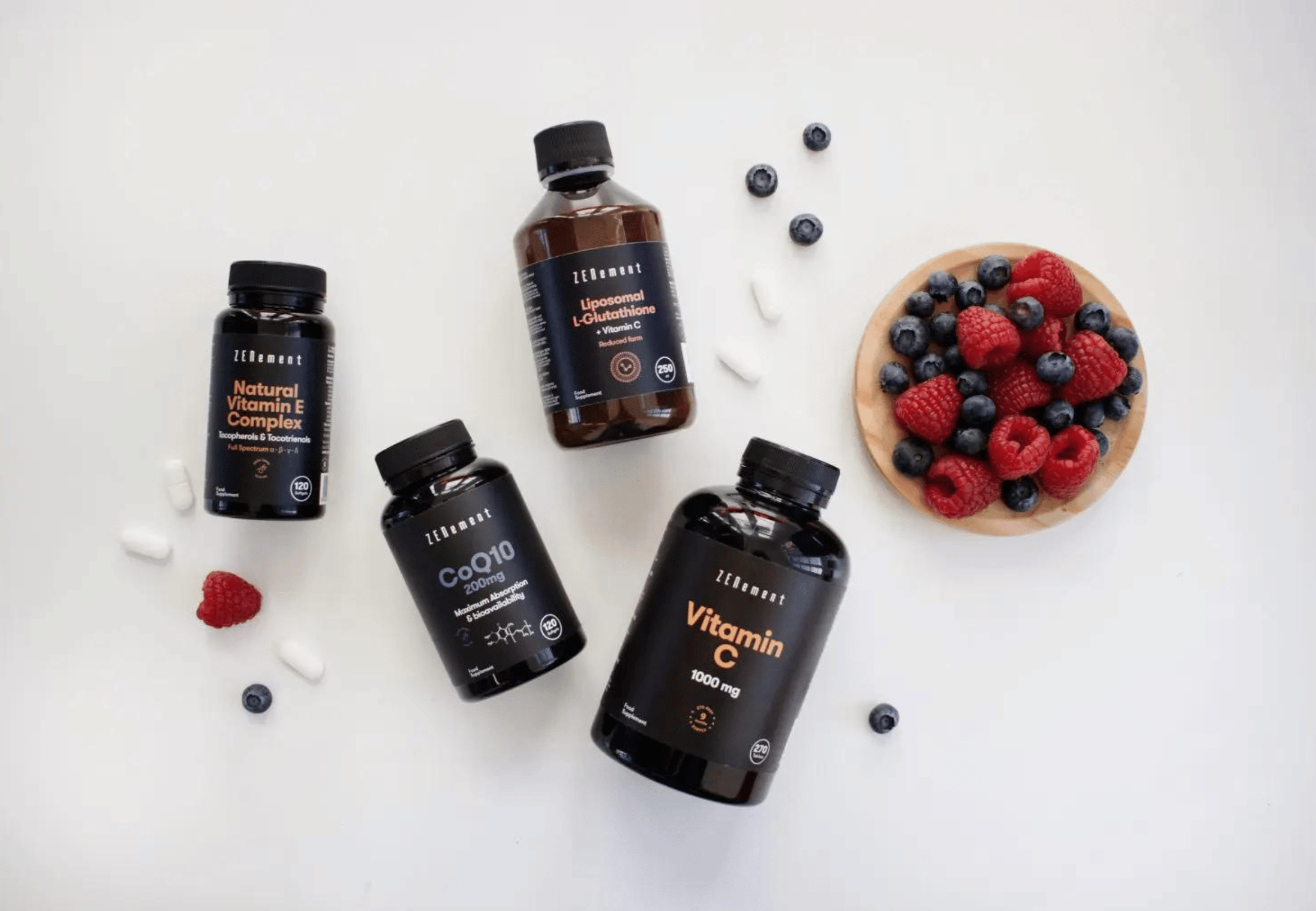In our daily life we are continuously exposed to both exogenous and endogenous agents. These are internal or external harmful substances that promote free radical formation that damage our organism. To counter this threat, cells have developed antioxidants, mechanisms that prevent or delay this damage. To ensure adequate antioxidant levels, it is very important to know the types of antioxidants that exist and what effect they have on our cells. In this post you will discover what types of antioxidants exist and which ones are best suited to your needs.
What are antioxidants?
Antioxidants are substances found in many different foods and also in food supplements that protect cells against damage caused by free radicals (highly reactive molecules that can damage DNA and other important cellular components).
We have identified 3 main types of free radicals: the superoxide molecule, the superoxide anion and hydrogen peroxide. Damage caused by free radicals has been linked to aging and pathologies such as type II diabetes, cardiovascular disorders and neurodegenerative diseases.
Antioxidants act as a protective shield as they can prevent or delay oxidative action thereby preventing cellular damage.
Types of antioxidants
There are several types of antioxidants, each with their own specific action mechanism and function within our bodies. They can be classified in several ways:
- Depending on their origin, they can be endogenous (produced by our bodies) or exogenous (obtained through diet or food supplements).
- Depending on their water or fat solubility, they can be water-soluble (they dissolve in water and are spread throughout our bodies through our blood) or fat-soluble (they dissolve in fat and are stored in our body’s fatty tissues).
In the following diagram we classify our antioxidants according to their origin and solubility:

|
Did you know…? Knowing whether an antioxidant is water-soluble or fat-soluble can help you when taking them and maximise their absorption. For example, vitamin C, being water-soluble, will be better absorbed if taken with a glass of water. Vitamin E, on the other hand, being fat-soluble, will be better absorbed if taken with a fatty food such as olive oil. |
Endogenous antioxidants:
Glutathione
L-glutathione is a protein found in every cytoplasm of every cell found in the human body that prevents cellular oxidation, helps regulate metabolism and maintain a healthy immune system. It is made up of three amino acids (cysteine, glycine and glutamic acid) and, although it is produced naturally in the body, it can be obtained from food.
It is present in fruits, green leafy vegetables, meats, fish, seeds and eggs. It should be noted that glutathione degrades easily when cooked and stored, so the way we cook these foods will influence the content of this antioxidant.
Coenzyme Q10
Coenzyme Q10 is a natural antioxidant found in the body. It plays an important role in producing cellular energy, specifically in the mitochondria, the cell’s “power plants”. Coenzyme Q10 levels decline as we age, so it is advisable to make sure you get an adequate intake.
Seafood, especially tuna, salmon and trout, are the richest sources of coenzyme Q10. It can also be found in nuts such as walnuts, sesame and sunflower seeds.
Exogenous antioxidants
Vitamin C
Vitamin C acts by neutralising harmful substances, but it is also essential for strengthening the immune system and for the synthesis/repair of tissues throughout the body (it is necessary for collagen synthesis, as it takes part in the so-called hydroxylation reactions, which stabilise the collagen structure). Severe vitamin C deficiency after cutting back on its consumption over a period of time can lead to scurvy (caused by a defect in collagen synthesis). According to the EFSA (European Food Safety Authority) there is no maximum daily limit for this vitamin.
To obtain vitamin C through your diet, you can eat fruits such as oranges, strawberries and kiwi or vegetables such as peppers, spinach and broccoli.
Quercetin
Quercetin is a plant pigment whose main function is senolytic, i.e. it helps to eliminate senescent or “old” cells; it is an anti-ageing mechanism. It also has anti-inflammatory properties that contribute to general well-being.
Some foods particularly rich in quercetin are plant-based, such as red grapes, onions, green tea, apples and berries.
Vitamin E
Vitamin E is highly effective when it comes to protecting polyunsaturated fatty acids, such as omega-3, found in cell membranes and the brain from oxidation. It is also important when it comes to maintaining healthy tissues such as skin and eyes, it takes part in the formation of red blood cells and has anti-inflammatory properties. According to EFSA, the recommended daily intake for adults is 300 mg/day.
Among foods rich in vitamin E, vegetable oils are the most important and to a lesser extent, it is found in seeds and cereals. Wheat germ oil is the richest natural source of vitamin E.
Trans-Resveratrol
Resveratrol is a plant pigment which, in addition to having anti-ageing properties due to its antioxidant activity, is associated with increased insulin sensitivity and cardiovascular health benefits.
It is present in certain Plant-based foods such as the skins of red grapes, redcurrants, blackberries and peanuts. It is also found in high concentrations in Fallopia japonica root (Polygonum cuspidatum), a shrub with healing properties.
Astaxanthin
Astaxanthin is a natural carotenoid pigment with powerful antioxidant properties. It has 14 and 64 times the antioxidant power of vitamin E and vitamin C, respectively. It is also credited with a number of health benefits, such as reducing the risk of heart disease due to its anti-inflammatory properties, protecting against UV sun damage and improving skin health.
It is naturally found in seafood such as salmon, trout, krill, shrimp, crayfish and some types of seaweed and microalgae.
In this post we have learned how important antioxidants are when it comes to protecting our cells and tissues. Now that you know the properties of some of the most important antioxidants, you have the necessary tools to choose the ones that best suit you and combine them to enhance their effects according to your goals.
If you want to continue to expand your knowledge about antioxidants and learn more about their benefits, we invite you to check out our post 6 tips to increase your antioxidant levels, where we give you some tips on how to get extra antioxidants through a healthier lifestyle and supplementation.


